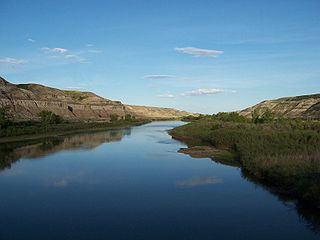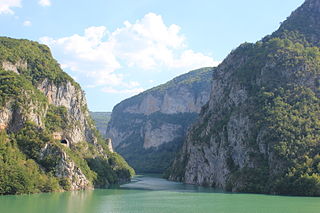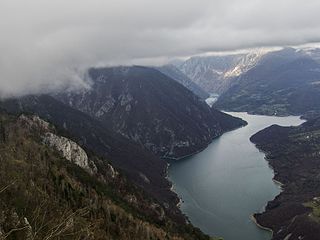| Česma | |
|---|---|
| Country | Croatia |
| Physical characteristics | |
| Main source | 114 m (374 ft) |
| River mouth | Lonja 84 m (276 ft) 45°34′31″N16°28′16″E / 45.57528°N 16.47111°E Coordinates: 45°34′31″N16°28′16″E / 45.57528°N 16.47111°E |
| Length | 105.7 km (65.7 mi) [1] |
| Discharge |
|
| Basin features | |
| Progression | Lonja→ Sava→ Danube→ Black Sea |
| Basin size | 3,253 km2 (1,256 sq mi) [1] |
| Tributaries |
|
Česma is a river in central Croatia, a left tributary of the river Lonja-Trebež. It is 106 km (66 mi) long, and its catchment area is 3,253 km2 (1,256 sq mi). [1]

A river is a natural flowing watercourse, usually freshwater, flowing towards an ocean, sea, lake or another river. In some cases a river flows into the ground and becomes dry at the end of its course without reaching another body of water. Small rivers can be referred to using names such as stream, creek, brook, rivulet, and rill. There are no official definitions for the generic term river as applied to geographic features, although in some countries or communities a stream is defined by its size. Many names for small rivers are specific to geographic location; examples are "run" in some parts of the United States, "burn" in Scotland and northeast England, and "beck" in northern England. Sometimes a river is defined as being larger than a creek, but not always: the language is vague.

Croatia, officially the Republic of Croatia is a country at the crossroads of Central and Southeast Europe, on the Adriatic Sea. It borders Slovenia to the northwest, Hungary to the northeast, Serbia to the east, Bosnia and Herzegovina, and Montenegro to the southeast, sharing a maritime border with Italy. Its capital, Zagreb, forms one of the country's primary subdivisions, along with twenty counties. Croatia has an area of 56,594 square kilometres and a population of 4.28 million, most of whom are Roman Catholics.
Created by merging streams Grđevica and Barna at 45°43′32″N17°03′01″E / 45.72556°N 17.05028°E near the village of Pavlovac in the municipality of Veliki Grđevac. Česma basin is fan-shaped and formed by a number of streams rising on the slopes of Bilogora and Moslavačka gora hills. Southern sides of Bilogora slightly goes downhill, rugged with numerous ravines and gullies, steeply and deeply cut in. On the sides appears numerous springs, that in the dry part of the year losing water.

A stream is a body of water with surface water flowing within the bed and banks of a channel. The stream encompasses surface and groundwater fluxes that respond to geological, geomorphological, hydrological and biotic controls.
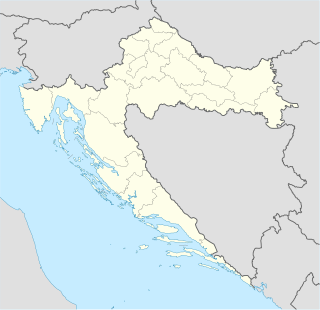
Pavlovac is a village in the municipality Veliki Grđevac, Bjelovar-Bilogora County in Croatia. According to the 2001 census, there are 679 inhabitants, in 242 family households.

Veliki Grđevac ) is a municipality in Bjelovar-Bilogora County, Croatia. According to the 2001 census, there are 3,248 inhabitants, 80.41% of which are Croats, in 1,157 of family households.
It has a small drop (small difference in altitude between the source and the mouth) which was causing frequent floods before the regulation of the riverbed. The area around the watercourse of Česma till a hundred years ago was subject of flooding, which is why it was swampy. After that, Česma river and its tributaries was channelized, embankments were built for flood protection, and the soil is dried to obtain arable land as well as the fight against malaria.

A flood is an overflow of water that submerges land that is usually dry. In the sense of "flowing water", the word may also be applied to the inflow of the tide. Floods are an area of study of the discipline hydrology and are of significant concern in agriculture, civil engineering and public health.

A stream bed or streambed is the channel bottom of a stream or river, the physical confine of the normal water flow. The lateral confines or channel margins are known as the stream banks or river banks, during all but flood stage. Under certain conditions a river can branch from one stream bed to multiple stream beds. A flood occurs when a stream overflows its banks and flows onto its flood plain. As a general rule, the bed is the part of the channel up to the normal water line, and the banks are that part above the normal water line. However, because water flow varies, this differentiation is subject to local interpretation. Usually, the bed is kept clear of terrestrial vegetation, whereas the banks are subjected to water flow only during unusual or perhaps infrequent high water stages and therefore might support vegetation some or much of the time.
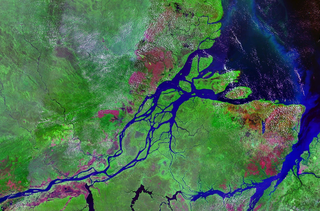
A watercourse is the channel that a flowing body of water follows. In the UK, some aspects of criminal law, such as The Rivers Act 1951, specify that a watercourse includes those rivers which are dry for part of the year.
At the site of former wetlands now are fish ponds that supply water from streams that flows into the Česma river. These ponds are one of the last refuge of wading birds between the Drava and Sava rivers.
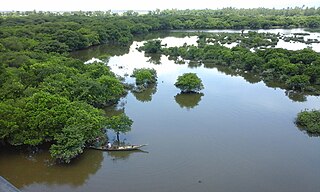
A wetland is a distinct ecosystem that is inundated by water, either permanently or seasonally, where oxygen-free processes prevail. The primary factor that distinguishes wetlands from other land forms or water bodies is the characteristic vegetation of aquatic plants, adapted to the unique hydric soil. Wetlands play a number of functions, including water purification, water storage, processing of carbon and other nutrients, stabilization of shorelines, and support of plants and animals. Wetlands are also considered the most biologically diverse of all ecosystems, serving as home to a wide range of plant and animal life. Whether any individual wetland performs these functions, and the degree to which it performs them, depends on characteristics of that wetland and the lands and waters near it. Methods for rapidly assessing these functions, wetland ecological health, and general wetland condition have been developed in many regions and have contributed to wetland conservation partly by raising public awareness of the functions and the ecosystem services some wetlands provide.

A fish pond, or fishpond, is a controlled pond, artificial lake, or reservoir that is stocked with fish and is used in aquaculture for fish farming, or is used for recreational fishing or for ornamental purposes. In the medieval European era it was typical for monasteries and castles to have a fish pond.

Waders are birds commonly found along shorelines and mudflats that wade in order to forage for food in the mud or sand. They are called shorebirds in North America, where the term "wader" is used to refer to long-legged wading birds such as storks and herons. Waders are members of the order Charadriiformes, which includes gulls, auks and their allies.
Along Česma river there are several major fish farming complexes. North of Česma fish pond — ribnjačastvo Dubrava, and along the southern coast fish ponds — Siščani, Blatnica and Narta. Both complexes are spread at about 5 kilometers along the course Česma river, and environment are similar. They are about 5 kilometers away to each other. The total area covered by commercial fish ponds is 1,346 ha (3,330 acres). [2]

Fish farming or pisciculture involves raising fish commercially in tanks or enclosures such as fish ponds, usually for food. It is the principal form of aquaculture, while other methods may fall under mariculture. A facility that releases juvenile fish into the wild for recreational fishing or to supplement a species' natural numbers is generally referred to as a fish hatchery. Worldwide, the most important fish species produced in fish farming are carp, tilapia, salmon, and catfish.









